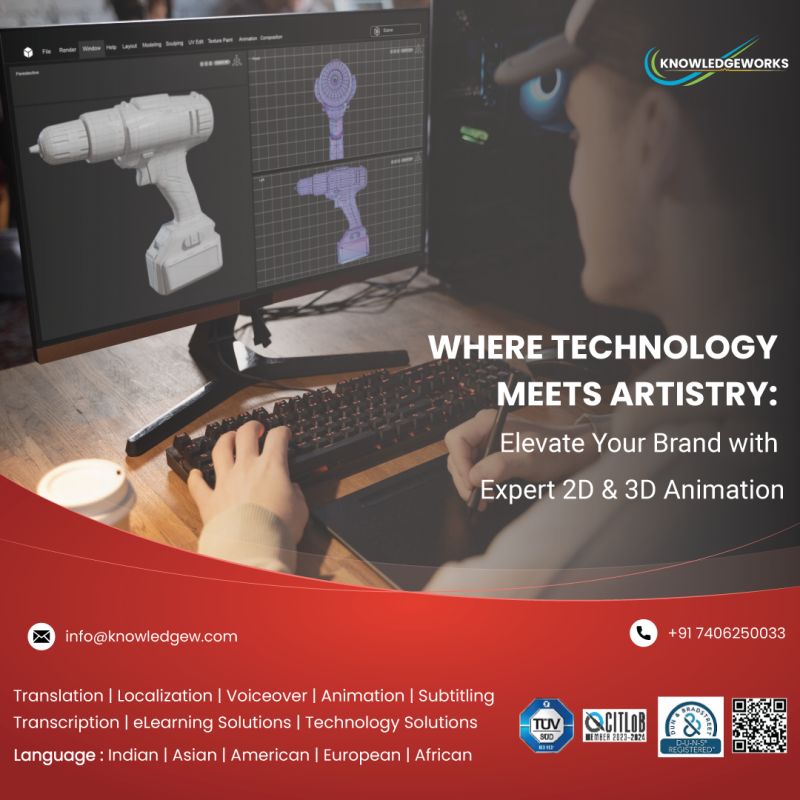The manufacturing industry has always been at the forefront of technological advancements, continually seeking ways to improve efficiency, accuracy, and communication. Among the various tools and techniques adopted by the industry, animation both 2D and 3D stands out for its versatility and impact. This article explores how 2D and 3D animation transform manufacturing processes, from design and development to training and marketing.
2D Animation: Simplicity and Clarity
Instructional Videos
2D animation is particularly effective for creating instructional content. Training workers on complex machinery and safety protocols can be challenging, but 2D animated videos simplify this process. These animations ensure that workers understand and remember the steps more effectively by breaking down intricate procedures into easily digestible segments.
These animations ensure that workers understand and remember the steps more effectively by breaking down intricate procedures into easily digestible segments
Assembly Guides
Manufacturers can use 2D animation to produce detailed assembly guides. Animated assembly instructions help technicians and customers follow along with ease, reducing errors and assembly time. This is especially useful for consumer products that require self-assembly.
Marketing and Sales
In marketing, 2D animations can bring products to life. Product demonstration videos that highlight key features and benefits clearly and engagingly can captivate potential customers. Explainer videos can demystify complex manufacturing processes, making them accessible to clients and investors who may not have a technical background.
User Manuals
Traditional user manuals can be cumbersome and difficult to follow. Converting these manuals into animated formats enhances comprehension and retention of information. Animated user manuals can guide users step-by-step, reducing the likelihood of mistakes and increasing customer satisfaction.
3D Animation: Realism and Precision
Product Design and Development
3D animation is a powerful tool in the product design and development phase. It allows designers to create highly detailed and realistic models of products, which can be examined and modified before any physical prototype is made. This not only saves time and resources but also enables the identification and rectification of potential issues early in the design process.
Simulation and Testing
With 3D animation, manufacturers can simulate how a product will perform under various conditions. This includes stress tests, thermal analysis, and motion studies. By visualising these scenarios, engineers can predict potential failures and optimise designs for better performance and durability.
Virtual Prototyping
Creating physical prototypes is often time-consuming and expensive. Virtual prototyping through 3D animation allows manufacturers to build and test prototypes in a virtual environment. This accelerates the development cycle and reduces costs associated with physical prototyping.
Training and Safety
3D animations can create immersive training experiences. For example, virtual reality (VR) training modules, which use 3D animation, can simulate real-world scenarios that workers may encounter. This hands-on approach to training improves skill acquisition and retention. Additionally, 3D animations can vividly depict safety procedures, helping to minimise workplace accidents.
Marketing and Sales
In the realm of marketing, 3D animations provide a high level of detail and realism that can impress potential customers. Detailed product visualisations and virtual tours of manufacturing facilities can be created, offering an engaging way to showcase capabilities and products. This can be particularly appealing in industries where the visual appeal and intricate details of products are critical to sales.
Conclusion
The integration of 2D and 3D animation services in Bangalore into the manufacturing industry is more than just a trend—it is a significant shift towards more efficient, effective, and engaging processes. Whether simplifying training, enhancing product design, or captivating customers with detailed visualisations, animation is proving to be an invaluable asset. As technology continues to evolve, the applications of animation in manufacturing will only expand, offering even greater opportunities for innovation and improvement.





Comments